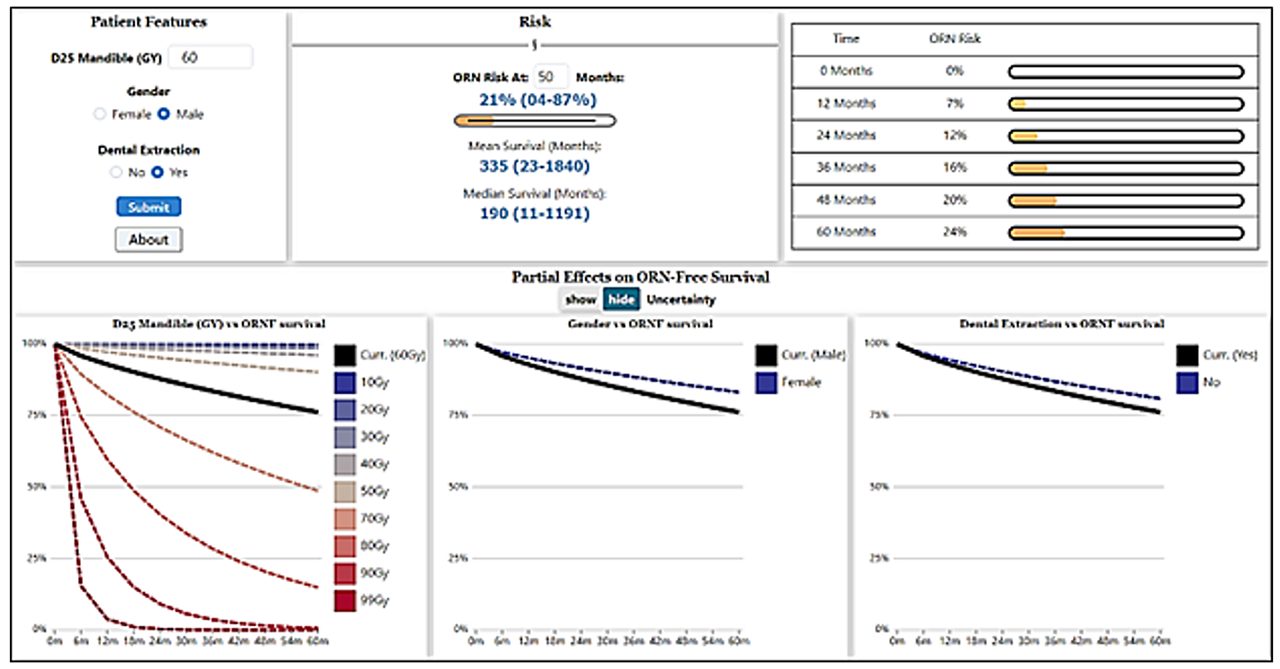Externally validated digital decision support tool for time-to-osteoradionecrosis risk-stratification using right-censored multi-institutional observational cohorts
April 11th, 2025
Categories: Applications, Software, Visualization, Visual Analytics, Data Science

Authors
About
Authors: Humbert-Vidan. L., Kamel, S., Wentzel, A., Kaffey, Z., Abdelaal ,M., Spier, K. B., West, N. A., Marai, G. E., Canahuate, G., Zhang, X, Chen, M.M., Wahid, K. A., Rigert, J., Hosseinian, S., Schaefer, A. J., Brock, K. K., Chambers, M., Otun, A. O., Aponte-Wesson, R., Patel, V., Hope, A., Phan, J., Garden, A. S., Frank, S. J., Morrison, W. H., Spiott, M. T., Rosenthal, D., Lee, A., He, R., Naser, M. A., Watson, E., Hutcheson, K. A., Mohamed, A. S. R., Sandulache, V. C., van Dijk, L. V., Moreno, A. C., Urbano, T. G., Fuller, C. D., Lai, S. Y.
Background
Existing studies on osteoradionecrosis of the jaw (ORNJ) have primarily used cross-sectional data, assessing risk factors at a single time point. Determining the time-to-event profile of ORNJ has important implications to monitor oral health in head and neck cancer (HNC) long-term survivors.
Methods
Data were retrospectively obtained for a clinical observational cohort of 1129 patients (198 ORNJ cases) with HNC treated with radiotherapy (RT) at The University of Texas MD Anderson Cancer Center. A Weibull Accelerated Failure Time model was trained on previously identified dosimetric, clinical and demographic predictors. External validation was performed using an independent cohort of 265 patients (92 ORNJ cases) treated at Guy’s and St. Thomas’ Hospitals. To facilitate clinical implementation of the model, an online graphical user interface (GUI) was developed, including formal stakeholder usability testing.
Results
Our model identified that gender (males), pre-RT dental extractions and D25% were associated with a 38 %, 27 % and 12 % faster onset of ORNJ, respectively, with adjusted time ratios of 0.62 (p = 0.11), 0.73 (p = 0.13) and 0.88 (p < 0.005). The model demonstrated strong internal calibration (integrated Brier score of 0.133, D-calibration p-value 0.998) and optimal discrimination at 72 months (Harrell’s C-index of 0.72).
Conclusion
This study is the first to demonstrate a direct relationship between radiation dose and the time to ORNJ onset, providing a novel characterization of the impact of delivered dose and patient-related factors not only on the probability of a late effect (ORNJ), but the conditional risk during survivorship.
Keywords: Osteoradionecrosis of the jaw, Time-to-event prediction models, Normal tissue complication prediction, Radiation-induced toxicity, Decision support tool, Radiotherapy, Head and neck cancers
https://doi.org/10.1016/j.radonc.2025.110890
Resources
URL
Citation
, Externally validated digital decision support tool for time-to-osteoradionecrosis risk-stratification using right-censored multi-institutional observational cohorts, April 11th, 2025. https://www.sciencedirect.com/science/article/pii/S0167814025001859?dgcid=coauthor